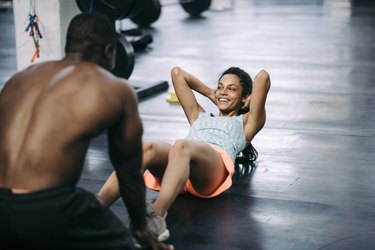
Push-ups and sit-ups have been the mainstay of home calisthenics routine for decades and with good reason. Between the two exercises, your core, your upper body and your back are strengthened. And of course there's the great advantage of having a well-rounded workout you can do anytime, anywhere — great for travel or when you don't have access to a gym.
It might be a stretch to call the two of them a complete workout pair, but understanding the respective benefits — and limitations — of each might help you decide how you want to integrate them into your exercise routine.
Video of the Day
Video of the Day
Tip
Push-ups and sit-ups strengthen your core, upper body and back.
Sit-Ups the Right Way
When most people think about working their abdominal muscles, they're primarily concerned with the rectus abdominus. That's the long sheath of muscle that, under the perfect conditions of low body fat, high conditioning and the right genetics, can be transformed into the proverbial six-pack abs.
While crunches work the upper rectus abdominus and leg-lifts work the lower, done properly, sit-up benefits include both. Exercise scientist Dr. Len Kravitz writing for the University of New Mexico advises visualizing the abdominals contracting tighter with each sit-up.
Concerns About Hip-Flexors
On the subject of sit-ups, detractors feel it's easy for the hip flexors, which connect to the front of the lower spine, to take over the work you want your abs to do. That diminishes ab activation and can strain the lower back, causing pain, especially if your abs are relatively weak. Plus, overworked or too-tight hip flexors can cause a forward pull on the lower spine, resulting in back problems.
Form Is Essential
To avoid these problems, make sure your head and neck muscles are completely relaxed and your neck straight. Your hands steady the head, not tug your body upward, which can hurt your neck and is also the main source of detracting from ab work. Your feet should be flat on the floor, shoulder-width apart and knees up. If you like sit-ups, you can keep your hip-flexors happy with moves like the kneeling hip-flexor stretch, says ACE Fitness.
Push-Ups All Around
Many trainers believe push-ups are as close to a perfect exercise as you can get and it's not hard to see why. Push-ups work muscle groups in the chest, arms, back and abdominal area. The push-up remains a long-standing measure of overall fitness by the U.S. military and elsewhere.
Read more: Proper Push-Up Technique
The act of pushing is one of five functional movement patterns identified by the American Council on Exercise, which recommends the assisted push-up and plank reaches among other moves to help you master the push-up.
Obviously, the ability to use your arms to move things away from your body — or vice versa — is quite necessary in everyday life. Since strong arms aren't much use without strong pectorals, shoulder and back muscles, the push-up is an all-around great exercise.
It's also one of the best things you can do to improve your posture because it opens and tones the pectorals, which, when tight, can contribute to sagging posture. Push-ups may also help resolve lower back pain by helping to strengthen the transverse abdominus and other core muscles implicated with lower back pain. "Bracing" your abdominals as if you were preparing for a gut punch while doing push-ups will help maximize activation of the core muscles.
Variations on the Theme
By applying various modifications, you can use push-ups to work hard-to-reach muscles. Move your hands closer together and arch your upper back toward the sky, and you have the push-up plus (PUP), also known as anterior serratus push-up. It's helpful for preventing rotator cuff problems, a hazard of sitting at the computer too much.